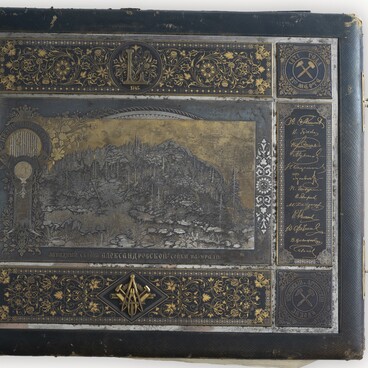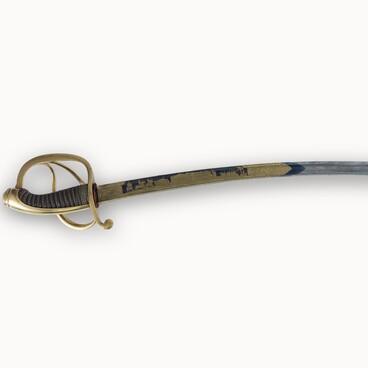In July 1904, the Moksha and Chernoyarsk formations were ceremonially sent off to the front of the Russo-Japanese War. The history section of the Zlatoust City Museum of Local Lore has a fragment of the blade of an officer’s dragoon sword of 1881.
This is a blade with one wide and two narrow grooves. One of its sides has an inscription “To the Commander of the 282nd Chernoyarsk Regiment, Colonel Polyansky” etched thereon, along with the facsimile signatures of the donators. The other side features another inscription — “From officers of the 282nd Chernoyarsk Regiment” and reproduced signatures of the officers. A factory stamp was affixed to the butt — “Zlat. Arms Factory”.
The commander of the Chernoyarsk Regiment, which had been formed in Zlatoust, was awarded orders and Golden Weapons for distinction in the Russo-Japanese war. The sword was presented to him by his fellow officers on April 5, 1906, as he was passing through the Zlatoust railway station.
Alexey Sergeyevich Polyansky was born on February 5, 1858. In 1877, he was released with the rank of ensign from the Kazan Cadet School and, as part of the Akhaltsikh Infantry Regiment, went to fight the Turks. Later he commanded units — from platoon to battalion. He assumed the command of the Chernoyarsk Regiment on July 24, 1905.
Alexey Polyansky participated with the regiment in all the battles of the Russo-Japanese War and was wounded. After the regiment was disbanded, he was appointed commander of the Reserve Tobolsk Regiment. On July 15, 1910, he received the rank of Major General and was appointed brigade commander of the 11th Siberian Rifle Division. He left for the war front in 1914 at the head of the 1st Caucasian Rifle Brigade.
In 1915, he already commanded the 24th Infantry Division with the rank of Lieutenant General. He was awarded the highest military distinctions — the Order of St. George, 4th Class, the Orders of St. Anna and St. Stanislav with swords, 1st Class, and the Order of St. Vladimir with swords, 2nd Class.
It is known that between 1917 and 1918, Polyansky was among the deputies of the Tyumen City Duma. His fate after the outbreak of the Civil War remains unknown. Nor is there any information on how a fragment of his Golden Sword ended up in the Zlatoust City Museum of Local Lore.
This is a blade with one wide and two narrow grooves. One of its sides has an inscription “To the Commander of the 282nd Chernoyarsk Regiment, Colonel Polyansky” etched thereon, along with the facsimile signatures of the donators. The other side features another inscription — “From officers of the 282nd Chernoyarsk Regiment” and reproduced signatures of the officers. A factory stamp was affixed to the butt — “Zlat. Arms Factory”.
The commander of the Chernoyarsk Regiment, which had been formed in Zlatoust, was awarded orders and Golden Weapons for distinction in the Russo-Japanese war. The sword was presented to him by his fellow officers on April 5, 1906, as he was passing through the Zlatoust railway station.
Alexey Sergeyevich Polyansky was born on February 5, 1858. In 1877, he was released with the rank of ensign from the Kazan Cadet School and, as part of the Akhaltsikh Infantry Regiment, went to fight the Turks. Later he commanded units — from platoon to battalion. He assumed the command of the Chernoyarsk Regiment on July 24, 1905.
Alexey Polyansky participated with the regiment in all the battles of the Russo-Japanese War and was wounded. After the regiment was disbanded, he was appointed commander of the Reserve Tobolsk Regiment. On July 15, 1910, he received the rank of Major General and was appointed brigade commander of the 11th Siberian Rifle Division. He left for the war front in 1914 at the head of the 1st Caucasian Rifle Brigade.
In 1915, he already commanded the 24th Infantry Division with the rank of Lieutenant General. He was awarded the highest military distinctions — the Order of St. George, 4th Class, the Orders of St. Anna and St. Stanislav with swords, 1st Class, and the Order of St. Vladimir with swords, 2nd Class.
It is known that between 1917 and 1918, Polyansky was among the deputies of the Tyumen City Duma. His fate after the outbreak of the Civil War remains unknown. Nor is there any information on how a fragment of his Golden Sword ended up in the Zlatoust City Museum of Local Lore.




